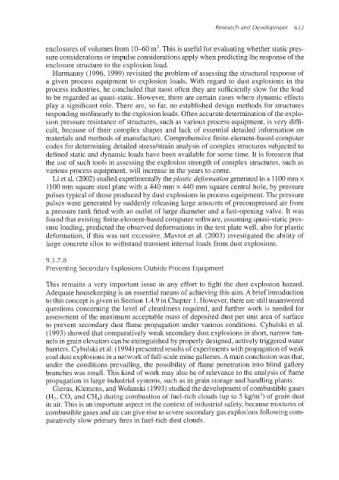Page 666 - Dust Explosions in the Process Industries
P. 666
Research and Development 633
enclosures of volumes from 10-60 m3.This is useful for evaluating whether static pres-
sure considerationsor impulse considerationsapply when predictingthe response of the
enclosure structure to the explosion load.
Harmanny (1996, 1999) revisited the problem of assessing the structural response of
a given process equipment to explosion loads. With regard to dust explosions in the
process industries, he concluded that most often they are sufficiently slow for the load
to be regarded as quasi-static. However, there are certain cases where dynamic effects
play a significant role. There are, so far, no established design methods for structures
responding nonlinearly to the explosion loads. Often accurate determinationof the explo-
sion pressure resistance of structures, such as various process equipment, is very diffi-
cult, because of their complex shapes and lack of essential detailed information on
materials and methods of manufacture. Comprehensive finite-element-based computer
codes for determining detailed stresshtrain analysis of complex structures subjected to
defined static and dynamic loads have been available for some time. It is foreseen that
the use of such tools in assessing the explosion strength of complex structures, such as
various process equipment, will increase in the years to come.
Li et d.(2002) studied experimentallytheplastic defomtion generated in a 1100mm x
1100mm square steel plate with a 440 mm x 440 mm square central hole, by pressure
pulses typical of those produced by dust explosions in process equipment.The pressure
pulses were generated by suddenly releasing large amounts of precompressed air from
a pressure tank fitted with an outlet of large diameter and a fast-opening valve. It was
found that existing finite-element-basedcomputer software,assuming quasi-staticpres-
sure lalading, predicted the observed deformations in the test plate well, also for plastic
deformation, if this was not excessive. Mavrot et al. (2003) investigated the ability of
large concrete silos to withstand transient internal loads from dust explosions.
9.3.7.8
Preventing Secondary Explosions Outside Process Equipment
This remains a very important issue in any effort to fight the dust explosion hazard.
Adequate housekeeping is an essential means of achieving this aim. A brief introduction
to this concept is given in Section 1.4.9in Chapter 1.However, there are stillunanswered
questions concerning the level of cleanliness required, and further work is needed for
assessment of the maximum acceptable mass of deposited dust per unit area of surface
to prevent secondary dust flame propagation under various conditions. Cybulski et al.
(1993) showed that comparatively weak secondary dust explosions in short,narrow tun-
nels in grain elevators can be extinguishedby properly designed, actively triggered water
barriers. Cybulski et al.(1994)presented results of experimentswith propagation of weak
coal dust explosionsin a network of full-scale mine galleries.Amain conclusion was that,
under the conditions prevailing, the possibility of flame penetration into blind gallery
branches was small. This kind of work may also be of relevance to the analysis of flame
propagation in large industrial systems, such as in grain storage and handling plants.
Gieras, Klemens, and Wolanski (1993) studied the developmentof combustiblegases
(H25CO, and CH,) during combustion of fuel-rich clouds (up to 5 kg/m3)of grain dust
in air. This is an important aspect in the context of industrial safety, because mixtures of
combustiblegases and aircan give rise to severe secondary gas explosionsfollowingcom-
paratively slow primary fires in fuel-rich dust clouds.

